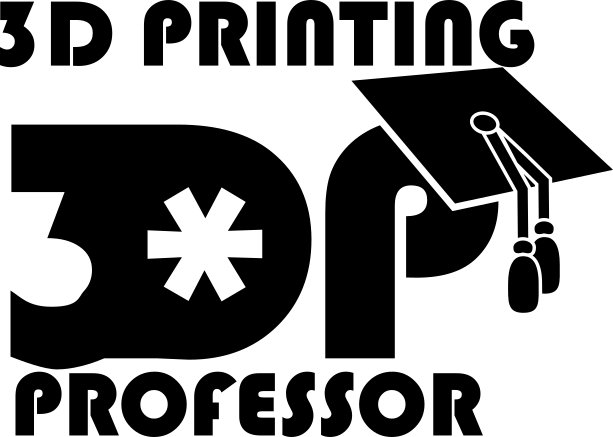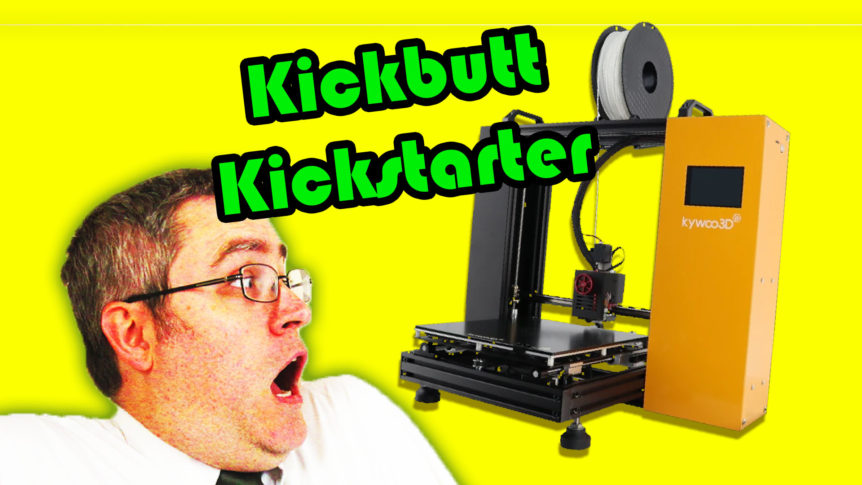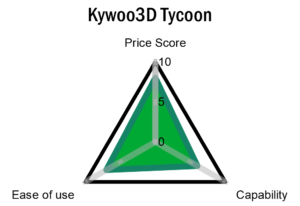 Whenever I review a 3D printer, I score it on a 3 axis scale: Price, Capability, Ease of Use. Each axis receives a score from 0 to 10, with a 10 being “impossibly good” and 0 being “impossibly bad. Though, there have been a few that got 0 scores on capability because they didn’t work, and the manufacturer refused to support their machine. The Price scale is pretty straight forward, though I had to adjust it to be somewhat logarithmic to make it useful. For instance, a free printer would be a 10, $200 is a 9, $400 is an 8, $800 is a 7, $1500 is a 6 and so on to $100000 being a 1. At this time Capability and Ease of use are mostly given a comparative score. I find a printer that is better than it and worse than it in that category, and I assign it a number accordingly. This score isn’t as objective as I’d like, and I think for a future March Madmess I need to adjust these scales with a rubric because it can be difficult to weigh all the elements going into a decision. For instance, the JGMaker A5S vs the Flashforge Creator Max. In the category of capability, the A5S is bigger, but the Creator Max has dual nozzles and direct drive. It could be argued that you’ll use the larger volume of the A5S more than the dual nozzles of the Creator Max, but how do they really compare?
Whenever I review a 3D printer, I score it on a 3 axis scale: Price, Capability, Ease of Use. Each axis receives a score from 0 to 10, with a 10 being “impossibly good” and 0 being “impossibly bad. Though, there have been a few that got 0 scores on capability because they didn’t work, and the manufacturer refused to support their machine. The Price scale is pretty straight forward, though I had to adjust it to be somewhat logarithmic to make it useful. For instance, a free printer would be a 10, $200 is a 9, $400 is an 8, $800 is a 7, $1500 is a 6 and so on to $100000 being a 1. At this time Capability and Ease of use are mostly given a comparative score. I find a printer that is better than it and worse than it in that category, and I assign it a number accordingly. This score isn’t as objective as I’d like, and I think for a future March Madmess I need to adjust these scales with a rubric because it can be difficult to weigh all the elements going into a decision. For instance, the JGMaker A5S vs the Flashforge Creator Max. In the category of capability, the A5S is bigger, but the Creator Max has dual nozzles and direct drive. It could be argued that you’ll use the larger volume of the A5S more than the dual nozzles of the Creator Max, but how do they really compare?
The system isn’t perfect (yet) but it does provide an interesting way to compare printers to each other. And since this graph creates a measurable triangle, and I can calculate the area of a triangle easy enough, I can use that area to weigh printers against each other.
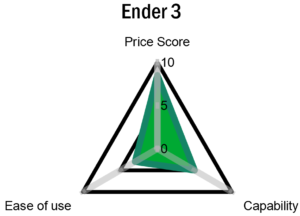 So, for instance, The Creatity Ender 3 has a Price score of 8.5 (at $300). It’s Capability is a 5 because of it’s build volume and single bowden extruder. And it’s Ease of Use score is a 4, since it requires quite a bit of assembly to get it running, even more fiddling to get it running well, has a minimal bare marlin interface, and frequently needs to be leveled, adjusted, or outright repaired. This creates a triangle with a total area of 41.5.
So, for instance, The Creatity Ender 3 has a Price score of 8.5 (at $300). It’s Capability is a 5 because of it’s build volume and single bowden extruder. And it’s Ease of Use score is a 4, since it requires quite a bit of assembly to get it running, even more fiddling to get it running well, has a minimal bare marlin interface, and frequently needs to be leveled, adjusted, or outright repaired. This creates a triangle with a total area of 41.5.
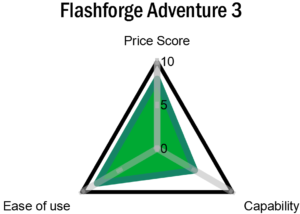 The Flashforge Adventure 3, however, has a Price score of 8 (at $400), Capability score of 5 because while it’s build volume is smaller, it’s enclosed, making it able to handle more materials, and an impressive Ease of Use score of 8 because it’s ready to go out of the box, works great, hardly ever needs maintenance, and it features and easy to swap nozzle. This creates a much larger total area of 72.
The Flashforge Adventure 3, however, has a Price score of 8 (at $400), Capability score of 5 because while it’s build volume is smaller, it’s enclosed, making it able to handle more materials, and an impressive Ease of Use score of 8 because it’s ready to go out of the box, works great, hardly ever needs maintenance, and it features and easy to swap nozzle. This creates a much larger total area of 72.
What I like about this system is it create an environment where I can be more objective in saying that one printer is better or worse than another. Yes, an Ender 3 is cheaper than an Adventure 3, but you get so much more for the price, more than you’d be able to expect for a little more money. The adventure 3 really hits above it’s weight.
So where does the Kywoo3D Tycoon rank in this not completely not arbitrary system of judging 3D printers? Sorting the list by it’s triangle’s calculated area it goes like this:

Of the 30 or so printers I’ve ranked the score of, these are the top, and the Kywoo3D Tycoon is currently sitting at #2, only below the JGMaker ArtistD, and that owing to it’s immense capability score and impressive price. Though if I adjust the Artist-D’s Price to the 7.5 that it’s usual $600 retail price says it is, it drops considerably down the list, and the Tycoon becomes #1. Fortunatly at this time I’ve never actually seen the Artist D at $600 because it’s always discounted, but that may change.
I had to double check this. I had to make sure I wasn’t grading it easier than it should be or grading another printer harder than it should be. but no. According to my own scale, the Kywoo3D may be the best 3D printer. It’s not the most capable. It’s not the easiest to use. It’s not even the cheapest. But it fills out it’s area of effect so well that the sum of all it’s parts says Kywoo3D should maybe wear the crown.
So, yeah. You owe it to yourself to check out the Kywoo3D Tycoon. A Kick-Butt Kickstarter.
